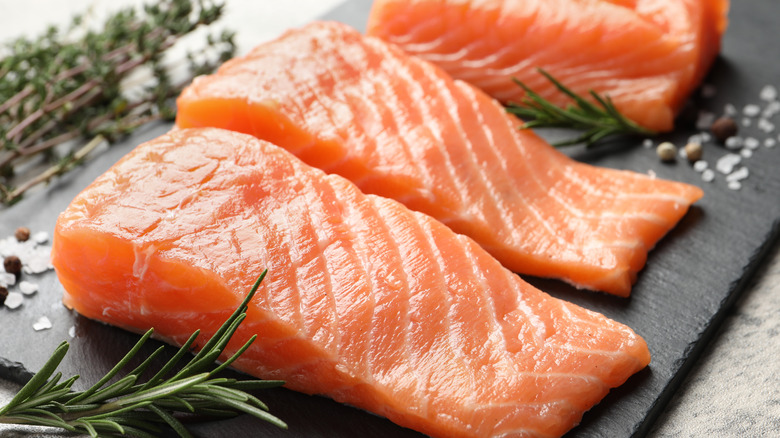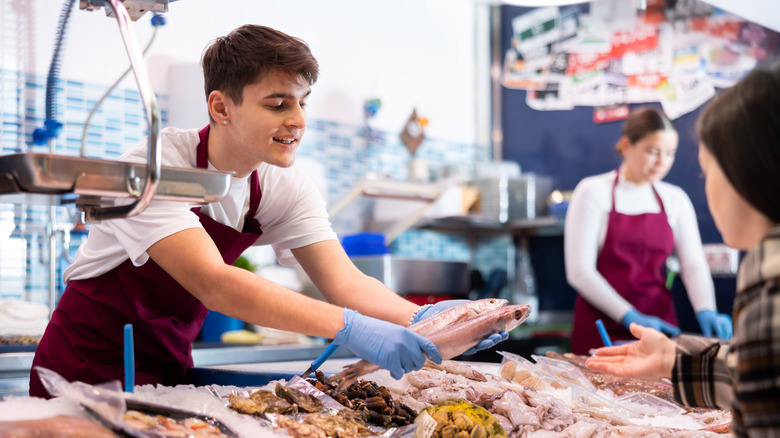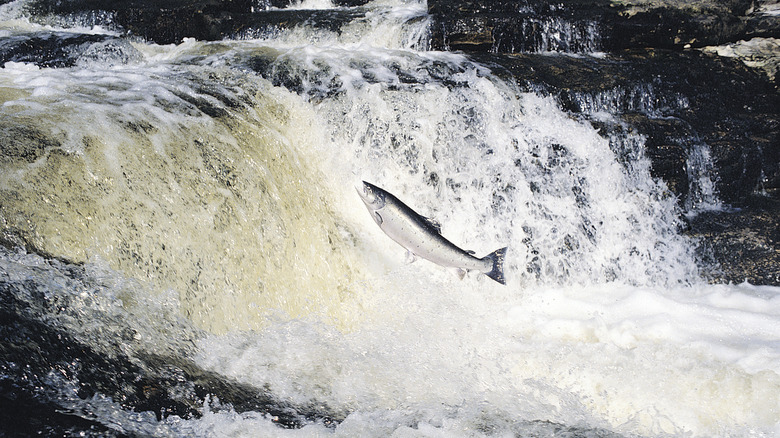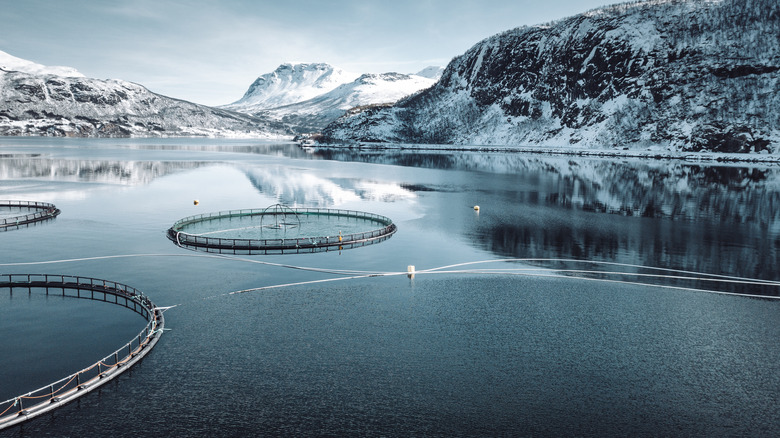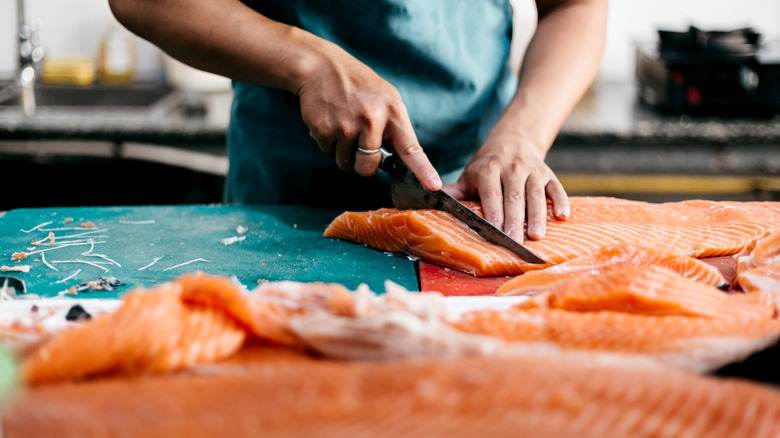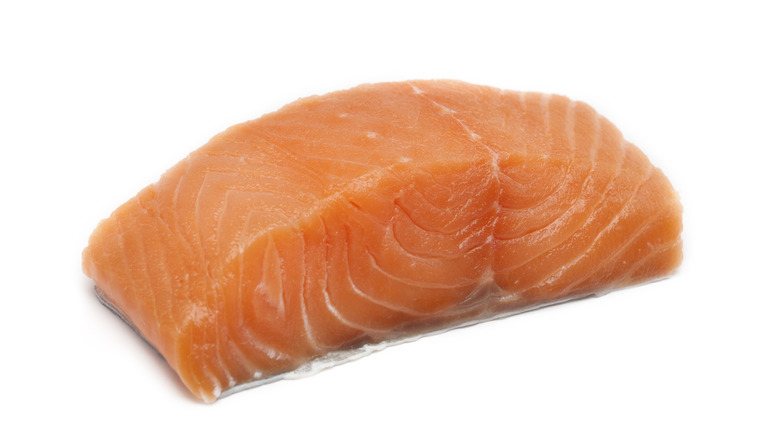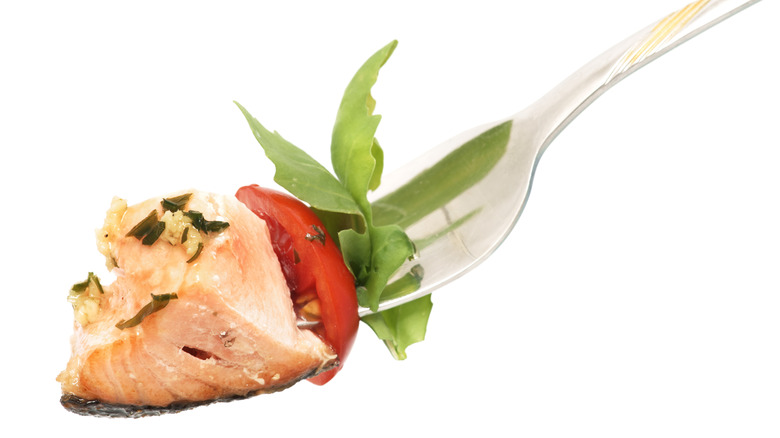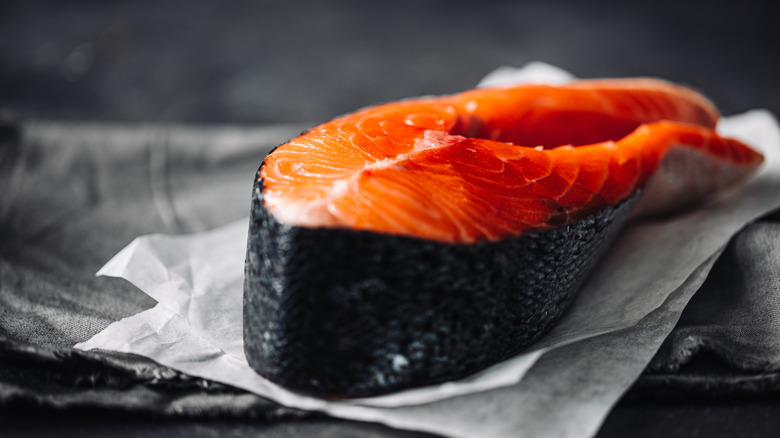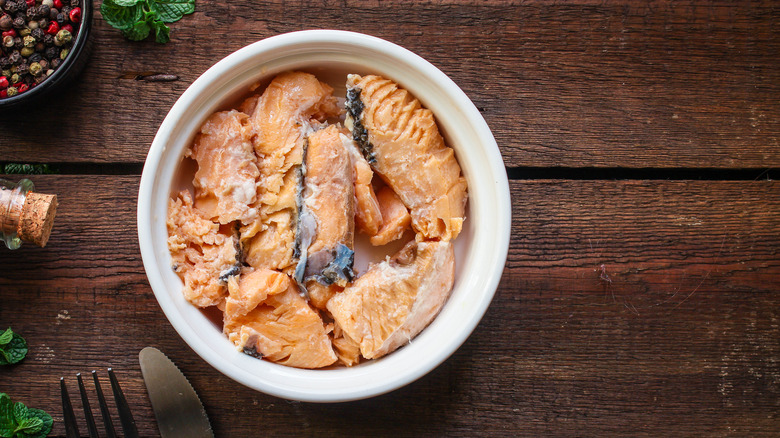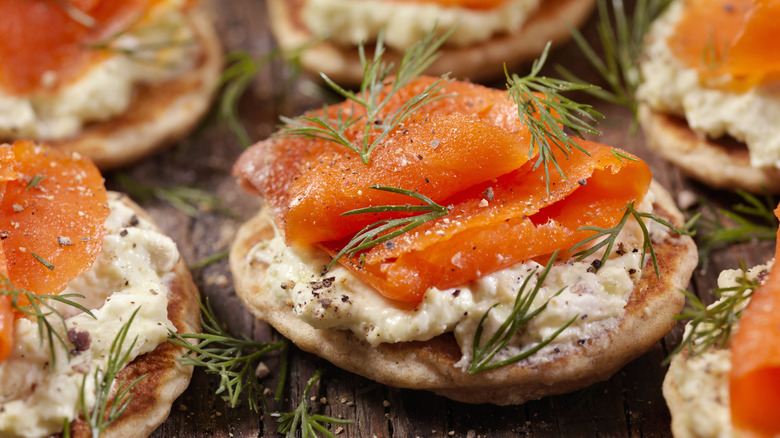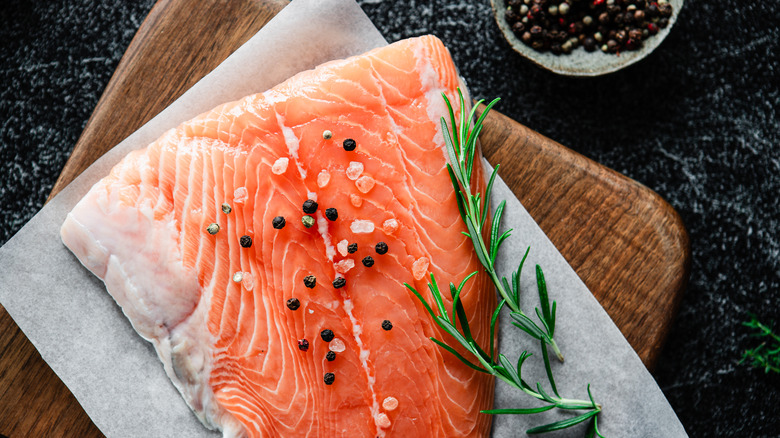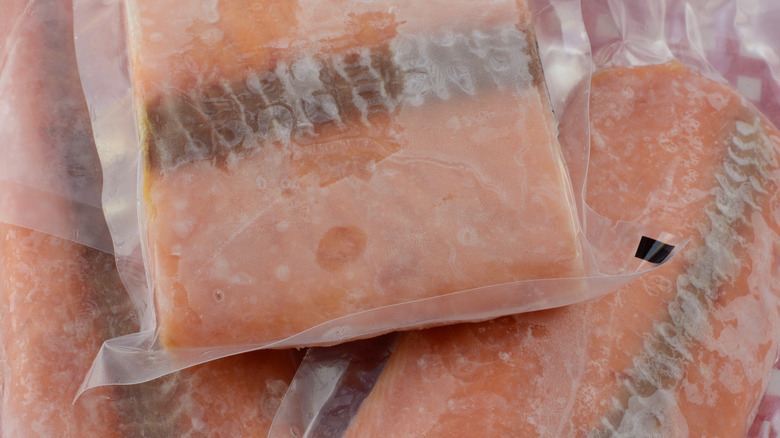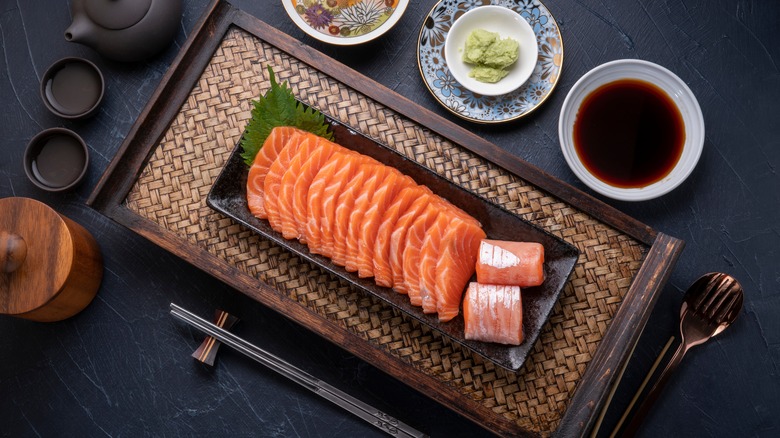The Ultimate Guide To Buying Salmon At The Grocery Store
We may receive a commission on purchases made from links.
It's a Wednesday night, and you just can't manage to get down to the docks for fresh salmon. For one thing, "the docks" are three hours away from where you live. For another, you'd rather just buy it at the same grocery store you hit up several times a week, thank you very much.
Yet choosing fish at the meat counter is a confusing welter of options and signs, most of them declaring that this particular cut of fish is better than all the others. (Can they really all be better than all the others?) So what's a poor harried home cook to do?
Simple: you need a comprehensive guide to choosing salmon at the grocery store. What are the differences between farmed and fresh? Does it matter if the salmon comes from New Zealand or Iceland or Alaska? What's with the different types, the different cuts, and skin-on? Should you ever brave an entire salmon? And what does a good piece of salmon look like to the naked eye? In this guide, you will learn the answers to these questions and more, so that the next time you walk into the store you'll have the confidence to get the best product all around.
A brief history of salmon
Most of us know salmon when we see it, but are unaware of the long history of this delicious, red-fleshed fish in human civilization. Salmon have been at the heart of tribal culture in the Americas for millennia. They are seen as sacred animals and play a critical role in the traditions of Indigenous peoples, who were also instrumental in fighting back against salmon depopulation due to overfishing and pollution. They abide by the scientifically attested belief that salmon are an indicator species, e.g. one whose health or decline is directly tied to that of the whole ecosystem.
Salmon have also been found in caves in the Caucasus Mountains dating back 45,000 years. According to research conducted at Universitaet Tübingen, salmon bones have been found at Pleistocene sites likely inhabited by Neanderthals, casting doubt on a prevailing hypothesis that Homo neanderthalensis gave way to Homo sapiens (us) due to a lack of dietary range. Their probable consumption of this ancient fish indicates there's probably another reason they died out.
Salmon have comprised part of the diet in areas as diverse as Northern Europe, the East and West Coasts of the Americas, and Asia. Today, it is no less beloved around the world.
Why buy salmon at a store?
While we don't often consider the life cycle of, say, our asparagus, that of salmon matters deeply to the environment. Salmon are anadromous, meaning they spend some of their time in freshwater where they're born, hang out in saltwater for a few years, come home to breed, and then die. Their life cycle is therefore delicate and regulated like other game, which means that non-farmed salmon can only be caught at certain times of the year. It's important not to fish them during breeding season because some species of salmon are endangered or protected under law.
Aside from pure convenience, the best reason to buy salmon at the grocery store is because stores are likelier to respect the law than unvetted individuals. That is not to say that individual anglers are breaking the law, but if you buy outside the grocery store, you should be careful.
Where possible, try to buy salmon from Indigenous communities when you can. Their ancient heritage depends on this species, and they take great care to preserve the ecology of rivers and oceans. You can find options in your area by searching "Indigenous salmon brands," then asking for them at the store or, barring that, finding them online.
Salmon names and breeds
Salmon can be confusing. There are just so many kinds of them, and they all have more than one name per species. Chinook salmon (Oncorhynchus tshawytscha) is also called king salmon, Quinnat salmon, and spring salmon. Sockeye salmon (Oncorhynchus nerka) are also called red salmon. Others include coho (Oncorhynchus kisutch), pink (Oncorhynchus gorbuscha), and chum (Oncorhynchus keta), each of which has several to dozens of other possible nicknames.
Making it more confusing, Norwegian salmon is just Atlantic salmon (Salmo salar), causing it to appear as though there exists more than one salmon breed in the Atlantic. There isn't; it's just marketed differently depending on where it comes from.
The good news is, most salmon cooks up roughly the same, so you can feel confident buying most types of fresh salmon for most types of recipes. You can be more specific if you want, such as researching the best types of salmon to grill or looking up species-specific recipes online, of which you will find many.
What's the difference between wild-caught and farmed?
Before you get to cooking and eating salmon, there's more to learn about buying it, and that starts with wild-caught versus farmed. Pacific salmon includes Chinook, Sockeye, and Coho. These are usually wild-caught (though not always), which means that they're fished out in the open ocean using lines or nets. However, all of these species can also be farmed. Because they are protected, Atlantic salmon on the American market are farmed.
Whether the salmon you choose is farmed or fished, it's important to take into account how it is caught or raised if you want the best and most sustainable fish. Farmed salmon can be safe as long as the company is responsible, even if it has some health issues associated with it (see "Health benefits of salmon"). Take caution with wild-caught salmon, because some breeds are snagged with nets, which is dangerous to wildlife.
If a salmon is farmed, most grocery stores will usually announce that on the tag. If not, ask the fishmonger, who should be able to tell you. If they can't, red flag: Don't buy that salmon, as you don't know the manner of its procurement. Note that farmed salmon may hail from far away from their normal habitat and migratory range, which is okay as long as the farm follows strict standards. Many don't, leading to escaped fish and environmental issues, so do your research by reading tags and asking at the counter.
What makes for sustainable salmon?
Many people, when standing at the fish counter, feel a sense of existential dread about picking their steaks or fillets. For good reason: Several concerns have arisen among the public about farmed salmon over the years. For one thing, some farmed salmon are genetically modified, creating worries about what might happen to the wild fish population if salmon were to escape their farms.
Luckily, there's basically no chance this can happen. Genetically modified salmon are confined to land-based tanks owned by the company AquAdvantage Salmon, where there's essentially zero chance the fish or eggs could leak into the wild. Thus, if you buy genetically modified salmon, you can feel safe that the Food and Drug Administration (FDA) has approved it, environmentally speaking.
However, farmed salmon does come with higher rates of toxicity. Fish consume frequently undisclosed amounts of pesticides and antibiotics, and exist on unnatural pellet diets rather than their normal omnivorous eating habits in the wild. According to TIME, it's not as humane for fish, either, with estimates ranging between 15-20% for the number of fish that die before harvesting. The most sustainable salmon choices are wild and line-caught, whether fresh or in cans.
How can you tell the fish is fresh?
Let's assume that you have picked your type of salmon, based on your own personal principles, and are happy with your choice. The question now becomes a culinary one: Is that a good piece of fish? Many people aren't sure how to tell whether the cut they're considering is a tasty choice or a waste of money.
There are many signs that salmon is fresh, including its sheen, moisture level, firmness, and smell. If you're buying whole salmon, you can also check the gills (which should be dark red) and the eyes (which should still be bright). Note that all of these apply to flash-frozen salmon, which can thaw out and be just as nice.
Whole salmon are often the freshest option at the grocery store because the flesh hasn't been sitting around exposed to the air. Where possible, buy a whole salmon and have your fishmonger fillet it for you. While they usually charge you for the price of the entire fish, you can save the head and bones for stock.
How should salmon taste?
When uncooked, salmon should taste clean, briny, and light, with a very mild sweetness. When cooking salmon, make sure it smells more like an ocean breeze than a dock, as the latter won't taste nice when it comes out of the oven or off the grill. If it smells or tastes bad, get rid of it right away; you never want to mess with spoiled fish.
Note that "fishy" and "bad" are two different things. A fishy smell is normal, while a garbage-y or carrion-like smell means you've got some dangerous bacteria going on. If you're still at "just fishy" level, there's something you can do about it, and that something is a cheap cedar plank. When you grill or bake fish on a cedar plank, it absorbs a pleasant, complex smoky taste, which overrides the fishiness. Just make sure to soak your plank in water for at least 30 minutes to avoid a housefire, which is no one's idea of a good time.
Which cuts of salmon to buy
Avoiding cheap cuts of salmon is the first mistake to avoid when buying it at the store. If it seems oddly inexpensive, you should ask about it. Maybe it is unsustainable, or worse, it's old and the seafood counter is pushing it. Sometimes, though, there's a surplus of fish and it's on sale. Just do your due diligence.
Next up, choose a cut that you know how to cook. Salmon steaks (crosswise cuts of both sides of a gutted fish) are popular, but make sure you have the patience to pull out the bones. Most people don't have it once the fish is on the plate in front of them. Fillets (cuts sliced off along the rib cage) are better, frequently boneless or with far fewer bones, and perfect for baking and grilling. Don't buy a whole fish unless you know how to fillet it, or plan to ask the fishmonger to do it.
If you're jonesing for sushi, the good news is that you can eat it raw from the store as long as you follow some basic safety tips. Indeed, it may even be safer than undercooked salmon. In this case, you'll want to opt for farm-raised salmon that has been flash-frozen. They are less likely to have ingested parasite-ridden wild food, and the freezing process helps kill any bugs that remain. Just note that pregnant women, children, elderly folks, and the immunocompromised should avoid it altogether.
What about canned salmon?
Although many people assume that a guide to salmon-buying only refers to the fresh variety, it also applies to canned. The untold truth about canned salmon is that it's nearly as healthy (and some studies have found that it might even be higher in nutrients, in some cases). Wild-caught is still better than farmed for environmental reasons, and you should look for specific factors when choosing your cans.
First, go for canned salmon that has bones. These are edible and high in calcium, making it a good choice for growing kiddos and adults alike. Try to choose low-sodium versions, as you can always add your own salt later. Any type of canned salmon is delicious, with nice pink flesh that mashes easily like tuna, so you needn't worry about the species.
You can do most things with canned salmon that you can do with canned tuna, including salmon salad, salmon melts, and more. If you don't use the entire can, make sure to store the remaining salmon safely in the fridge — more to come on that
Other types of storebought salmon
Fresh and canned salmon aren't the only types you'll find at the store. Another common type is frozen. While many people assume this isn't as good as the fresh variety at the counter, remember that many of those salmon choices are flash-frozen at sea. Hence, a frozen cut isn't as different as you might think.
The other types of store-bought salmon you'll find include candied salmon, smoked salmon, and lox. Smoked salmon is a pretty standard preparation that involves drying, smoking, and curing, while candied salmon involves the addition of brown sugar and maple syrup during a similar process.
Lox is a kind of brined and pressed salmon that is then thinly sliced and often put on bagels, popularized on smorgasbords. If you're feeling adventurous, you might also try salmon jerky, which is great protein for a hike or camping trip ... or just a snack at your kitchen table.
Where to buy salmon in every form
Most larger grocery stores will have a variety of salmon products available. The exception is candied salmon, which is harder to locate. This writer has only found it at mom-and-pop shops along the coast or made by friends and family who caught and smoked the salmon themselves. If you have a real hankering for it and don't live near your own source, you can also buy it online, but be prepared to shell out.
Almost every grocery store will have salmon in some form, either fresh or frozen. Smaller grocery stores may not have preserved varieties (such as lox and smoked fish), and they will likely have a smaller selection of canned salmon, if any. You can also buy fresh salmon online and participate in fish of the month clubs or subscription deliveries, where companies drop it off on your doorstep packed in ice, either in fresh or frozen form.
How to cook salmon for the best flavor
There are many ways to cook salmon: baking, grilling, sautéing, frying, broiling, poaching, steaming, and searing. Combine that variety with what you can put on it or serve with it, and you've got yourself an endlessly versatile fish that even kiddos love.
Many people prefer to cook salmon in the oven for a weeknight dinner, since all you have to do is turn on the oven or broiler and plop it on a pan. You can use a glass dish, but a metal pan is better if you want crispier skin on the bottom. Lining with parchment paper will prevent crusted-on juices that are hard to clean off, while a layer of olive oil above and below helps to keep your fish nice and moist. Sliced lemons and chopped herbs such as tarragon can impart a more nuanced flavor as well.
If you're tired of that white ooze that salmon sometimes emits during cooking, consider brining your fish beforehand. And while you might be tempted to cut calories, it's a mistake to remove salmon skin before you cook it. The skin holds the fish together, keeps it moist, imparts flavor, and protects it from burning, so keep it on until afterward or eat it along with your fish for a boost of healthy fat.
How to store salmon
You may store salmon fresh or frozen, but whatever you do, it's important to take some precautions. Both for health reasons and for the sake of your salmon's flavor and freshness, you should always thaw salmon under specific conditions. According to the United States Department of Agriculture, safe thawing methods include in the refrigerator, in water, or in the microwave. Thawing on the counter risks the salmon rising above 40 F, which is when bacteria begin to grow.
Fresh fish from the store should be left wrapped tightly in its butcher paper until you're ready to prep it, which you should ideally do that day or the next. The USDA advises you to cook salmon within 2 days and eat cooked salmon within 4 days (which would include any opened packages of cooked salmon in other forms, such as smoked and lox). Further, it recommends freezing cooked fish for only up to 3 months and raw fish for up to 8 months.
Salmon nutritional information
Salmon is incredibly good for you, though farmed and wild salmon aren't equal when it comes to nutrition and flavor. The health benefits of farmed salmon are somewhat in question, although they still exist in the form of heart-healthy Omega-3 fatty acids. However, the pollutant levels are higher compared to wild-caught salmon, and the saturated fats are more concentrated as well. Many people also think wild salmon has better flavor, since it has less fat by half, according to the Cleveland Clinic. However, some prefer the fattiness of farmed.
In general, though, salmon is a low-calorie food, with 3 ounces weighing in at only 120 calories, translating to about 200 for 5 ounces. If you keep the skin on a piece of fish, that number goes up to roughly 290 calories for 5 ounces. Salmon also contains an extensive list of vitamins and nutrients, which are denser in wild salmon and include calcium, iron, potassium, zinc, manganese, and dozens more.
